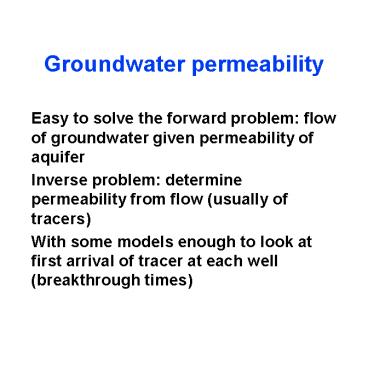Groundwater permeability - PowerPoint PPT Presentation
1 / 29
Title:
Groundwater permeability
Description:
Easy to solve the forward problem: flow of groundwater given permeability of aquifer Inverse problem: determine permeability from flow (usually of tracers) – PowerPoint PPT presentation
Number of Views:133
Avg rating:3.0/5.0
Title: Groundwater permeability
1
Groundwater permeability
- Easy to solve the forward problem flow of
groundwater given permeability of aquifer - Inverse problem determine permeability from flow
(usually of tracers) - With some models enough to look at first arrival
of tracer at each well (breakthrough times)
2
Notation
- ? is permeability
- b is breakthrough times
- expected breakthrough times
- Illconditioned problems different permeabilities
can yield same flow - Use regularization by prior on log(?)
- MRF
- Gaussian
- Convolution with MRF (discretized)
3
MRF prior
- where
- and njiij
4
(No Transcript)
5
Kim, Mallock Holmes, JASA 2005 Analyzing
Nonstationary Spatial Data UsingPiecewise
Gaussian Processes
- Studying oil permeability
- Voronoi tesselation (choose M centers from a
grid) - Separate power exponential in each regions
6
(No Transcript)
7
(No Transcript)
8
(No Transcript)
9
(No Transcript)
10
Nott Dunsmuir, 2002, Biometrika
- Consider a stationary process W(s), correlation
R, observed at sites s1,..,sn. - Write
- ?(s) has covariance function
11
More generally
- Consider k independent stationary spatial fields
Wi(s) and a random vector Z. Write - and create a nonstationary process by
- Its covariance (with ?Cov(Z)) is
12
Fig. 2. Sydney wind pattern data. Contours of
equal estimated correlation with two different
fixed sites, shown by open squares (a) location
3385S, 15122E, and (b) location 3374S,
14988E. The sites marked by dots show locations
of the 45 monitored sites.
13
(No Transcript)
14
Karhunen-Loéve expansion
- There is a unique representation of stochastic
processes with uncorrelated coefficients - where the ?k(s) solve
- and are orthogonal eigenfunctions.
- Example temporal Brownian motion
- C(s,t)min(s,t)
- ?k(s)21/2sin((k-1/2)?t)/((k-1/2)?)
- Conversely,
15
Discrete case
- Eigenexpansion of covariance matrix
- Empirically SVD of sample covariance
- Example squared exponential
- k1 5 20
16
Tempering
- Stationary case write
- with covariance
- To generalize this to a nonstationary case, use
spatial powers of the ?k - Large ? corresponds to smoother field
17
A simulated example
18
Estimating ?(s)
- Regression spline
- Knots ui picked using clustering techniques
- Multivariate normal prior on the ?s.
19
Piazza Road revisited
20
Tempering
More smoothness
More fins structure
21
Covariances
A
B
C
D
22
Karhunen-Loeve expansionrevisited
- and
- where ai are iid N(0,?i)
- Idea use wavelet basis instead of
eigenfunctions, allow for dependent ai
23
Spatial wavelet basis
- Separates out differences of averages at
different scales - Scaled and translated basic wavelet functions
24
Estimating nonstationary covariance using wavelets
- 2-dimensional wavelet basis obtained from two
functions?? and?? - First generation scaled translates of all four
subsequent generations scaled translates of the
detail functions. Subsequent generations on finer
grids.
detail functions
25
W-transform
26
Covariance expansion
- For covariance matrix ? write
- Useful if D close to diagonal.
- Enforce by thresholding off-diagonal elements
(set all zero on finest scales)
27
Surface ozone model
- ROM, daily average ozone 48 x 48 grid of 26 km x
26 km centered on Illinois and Ohio. 79 days
summer 1987. - 3x3 coarsest level (correlation length is about
300 km) - Decimate leading 12 x 12 block of D by 90,
retain only diagonal elements for remaining
levels.
28
ROM covariance
29
Some open questions
- Multivariate
- Kronecker structure
- Nonstationarity
- Covariates causing nonstationarity (or
deterministic models) - Comparison of models of nonstationarity
- Mean structure

